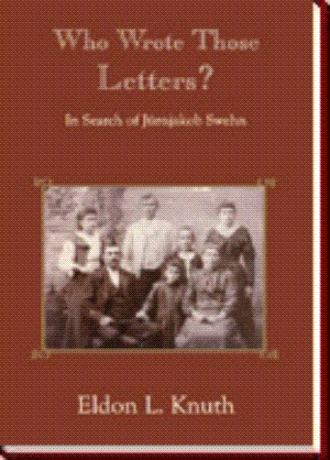After visiting several of the craftshops, we headed for Iowa County and our appointment with the Wiedows. Highway 151, through the Amana Colonies, was interesting. But Highway 80, with its long straight stretches and speeding trucks, was monotonous. After turning off on Victor Road, I stopped to check my notes regarding directions. But my briefcase with my notes, Wiedow files and the Jürnjakob Swehn book was not in the car! I had left it at the Bed and Breakfast! To go back to Amana and come back would take most of two hours; I had to do as best I could with my memory. The most awkward part was showing up without the highly-touted book.
Even though we arrived empty handed, we were greeted warmly. Present were Harold and Elsie Wiedow, Alton and Alice Wolf, and Sharon McKay, daughter of Alice Wolf. Harold and Alice, son and daughter of Charly Wiedow, lived not far from the farm on which Carl and Elisabeth had raised their family. The first visit with them was an emotional evening. They had never heard of the book, and could hardly believe that letters written by their grandfather had become so famous. For me, the search for Jürnjakob Swehn, which had its beginnings in 1976 in Schwerin, had reached a high point. We compared the book with their memories, frequently with agreement. They brought out old photos of the family, including a priceless photo of Carl, Elisabeth and their five children (Figs. 3.5-3.6). Henry''s gold watch, mentioned on p. 47 of the book [2], is still in the family. Henry received it when he graduated from high school. Since it is engraved HW, it has been passed down via family members with the same initials. We drove around the neighborhood. The barn on the old Wiedow farm still stood at that time (Fig. 3.7) but has been dismantled since then; the house had been replaced. Lincoln Township Schoolhouse No. 4, where Carl and Elisabeth''s two youngest children went to school, still stood (Fig. 3.8) although not in use; the original church schoolhouse has been replaced. The St. John''s Lutheran church, built in 1895, is still in use, but the steeple was replaced by a shorter steeple after it was toppled by a windstorm in 1950. (Figs. 3.9-3.11) Carl, Elisabeth, Carl''s father (Jochim) and Elisabeth''s mother (Maria Rösch) are buried in the church cemetery; Elisabeth''s father (Johann) is buried in Garnavillo, Iowa. The gravestone of Carl and Elisabeth is impressive. (Fig. 3.12) In two cases, the book contained information which the family members could not corroborate that evening. They did not know that Heinrich and Cora had a son; a subsequent search of family letters confirmed that they had a son and that he had passed away at an early age. They also did not remember the south side of the old house in sufficient detail to corroborate the description given on p. 25 of the book [2]; a subsequent search of family photos uncovered several photos of the house which fits Swehn''s description, including his description of the large window on the south side of the house. (Figs. 3.13-3.14) As we were getting ready to leave, Alice invited us to view more of the house. The living room reminded me of the living rooms I had known in Clayton County as a child -- well furnished and used mainly to entertain visitors. I was impressed by Alice''s display of doll-head vases. As we reluctantly parted company at the end of this memorable evening, Alic


